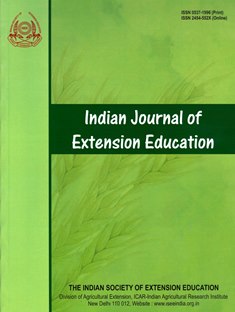Adoption and Compliance of AI-Enabled Pest Advisories: Evidence from the National Pest Surveillance System (NPSS) in Odisha, India
DOI:
https://doi.org/10.48165/IJEE.2025.61413Keywords:
AI-based pest advisories, Compliance, Digital pest surveillance, Integrated pest management, Smallholder agricultureAbstract
Artificial intelligence (AI)–enabled pest surveillance can bridge gaps between timely diagnosis and on-farm action in smallholder systems. This study assessed farmer exposure to and uptake of advisories from India’s newly launched NPSS in Odisha. An exploratory, cross-sectional inquiry was conducted during 2024–25 across 30 districts; one block and two villages per district were purposively selected based on NPSS use. Data were gathered from 1,422 participants through focus group discussions and personal interviews, and analysed. Paddy dominated the sample’s cropping pattern (66.17% of respondents), followed by brinjal (9.21%). Overall, 79.16 per cent were receiving NPSS advisories; the platform issued 851 advisories during the study, with 418 acted upon (49.11% adherence). Adherence declined as pest severity increased, especially for brown planthopper (BPH) and yellow stem borer (YSB) in paddy from 47.73 per cent (low severity) to 32.47 per cent (high severity), and YSB showed a similar drop (about 45.95% to 10%). Qualitative insights indicate lower uptake when recommendations involve costlier or more complex chemical controls, suggesting a need for clearer messaging, phased options, and enhanced last-mile support. The findings highlight substantial reach but moderate compliance, underscoring opportunities to tailor NPSS advisories to farmers’ resource realities and to strengthen capacity-building for higher-severity scenarios.
Downloads
References
Ashokkumar, B., & Naik, A. (2021). Transforming Indian agriculture with digital technologies. Asian Journal of Agricultural Extension, Economics & Sociology, 39(6), 76–90. https://doi.org/10.9734/ajaees/2021/v39i630596
Baliwada, H., Sharma, J. P., Burman, R. R., Nain, M. S., Kumar, A., & Venkatesh, P. (2017). Constraints and strategies in scaling up of farmer led innovations. Journal of Community Mobilization and Sustainable Development, 12(1), 72–78.
Baliwada, H., Sharma, J. P., Burman, R. R., Nain, M. S., Venkatesh, P., & Kumar, A. (2017). Economic impact assessment of farmer led innovations. International Journal of Agriculture Innovations and Research, 6(1), 14–20.
Baliwada, H., Sharma, J. P., Burman, R. R., Nain, M. S., Kumar, A., & Venkatesh, P. (2017). A study of institutionalization of farmer led innovations for their scaling up. Indian Journal of Agricultural Sciences, 87(12), 1725–1729.
Baliwada, H., Sharma, J. P., Burman, R. R., Nain, M. S., Kumar, A., & Venkatesh, P. (2018). A study of instigation of farmer led innovations and its spread. Journal of Community Mobilization and Sustainable Development, 13(1), 17–26.
Das, N., Modak, S., Prusty, A. K., Saha, P., & Suman, S. (2025). Understanding and overcoming key challenges of agripreneurs in southern Odisha: A case study. Indian Journal of Extension Education, 61(2), 118–122. https://doi.org/10.48165/IJEE.2025.612RN05
Ganai, M., Khan, Z., & Tabasum, B. (2018). Challenges and constraints in chemical pesticide usage and their solution: A review. International Journal of Fauna and Biological Studies, 5(3), 31–37.
Kabir, K. H. (2015). Attitude and level of knowledge of farmers on ICT-based farming. European Academic Research, 2(10), 13177–13196.
Khan, M., & Damalas, C. A. (2015). Factors prevnting the adoption of alternatives to chemical pest control among Pakistani cotton farmers. International Journal of Pest Management, 61(1), 9–16. https://doi.org/10.1080/09670874.2014.984257Khanganbi, T. V., & Priya, M. (2024). Social media addiction among the rural youth: An AI interpretation. Indian Journal of Extension Education, 60(2), 52–55. https://doi.org/10.48165/IJEE.2024.60210
Kumar, A. S., & Nandeesha, S. V. (2023). Pest surveillance and survey: Nature’s alarm to forewarn farmers. Vigyan Varta, 4(12), 72–75.
Mwenda, E., Muange, E. N., Ngigi, M. W., & Kosgei, A. (2023). Impact of ICT-based pest information services on tomato pestmanagement practices in the Central Highlands of Kenya. Sustainable Technology and Entrepreneurship, 2(2), 100036. https://doi.org/10.1016/j.stae.2022.100036
Nain, M. S., Singh, R., Mishra, J. R., & Sharma, J. P. (2018). Scalability of farmer led innovations (FLIs): A study of perceived determinants and required capacities. Indian Journal of Agricultural Sciences, 88(8), 1312–1315.
Prusty, A. K., Saha, P., Das, N., & Suman, S. (2025). Implementation and adoption of smart technologies in agri-allied sectors. Plant Science Today, 11(sp2). https://doi.org/10.14719/pst.3467
Sagar, N., Jakkawad, S. R., & Deshmukh, N. D. (2022). Constraints faced by beneficiary farmers in ‘Crop Pest Surveillance and Advisory Project’ and suggestions to overcome the constraints. The Pharma Innovation Journal, 11(12), 4177–4179.
Saha, P., Prusty, A. K., & Nanda, C. (2024). Extension strategies for bridging gender digital divide. Journal of Applied Biology and Biotechnology, 12(4), 76–80. https://doi.org/10.7324/JABB.2024.159452
Saha, P., Prusty, A. K., & Nanda, C. (2025). An overview of pluralism in agricultural extension and advisory services. International Research Journal of Multidisciplinary Scope, 6(1), 131–138. https://doi.org/10.47857/irjms.2025.v06i01.02074
Samanta, S., Barman, M., Nihal, R., & Samanta, A. (2020). Bio efficacy trials of Spinotetram 0.8% GR against yellow stem borer, Scirpophaga incertulas, and leaf folder, Cnaphalocrocis medinalis, infesting rice. International Journal of Current Microbiology and Applied Sciences, 9(2), 2711–2719. https://doi.org/10.20546/ijcmas.2020.902.308
Singh, N., & Gupta, N. (2016). ICT-based decision support systems for integrated pest management (IPM) in India: A review. Agricultural Reviews, 37(4), 309–316. https://doi.org/10.18805/ag.v37i4.6461
Singh, N., Tanwar, R. K., Ahuja, D. B., Sharma, O. P., Vennila, S., Birah, A., Bhagat, S., & Chattopadhyay, C. (2015). ICT-based integrated pest management system in India. SATSA Mukhapatra-Annual Technical Issue, 20, 39–45.
Suman, S., Deb, A., & Prusty, A. K. (2025). Constraints and strategic suggestions for enhancing integrated farming systems among Bonda tribal family farms. Indian Journal of Extension Education, 61(3), 132–136. https://doi.org/10.48165/IJEE.2025.613RN05
Suman, S., Deb, A., Prusty, A. K., Divya, B. S., & Saha, S. (2024). Utilizing blockchain, IoT and machine learning for transparent agri-extension and resource distribution: A review. In Proceedings of the 2nd International Conference on Signal Processing, Communication, Power and Embedded Systems (SCOPES 2024). https://doi.org/10.1109/SCOPES64467.2024.10991113
Downloads
Published
Issue
Section
License

This work is licensed under a Creative Commons Attribution-NonCommercial-NoDerivatives 4.0 International License.

